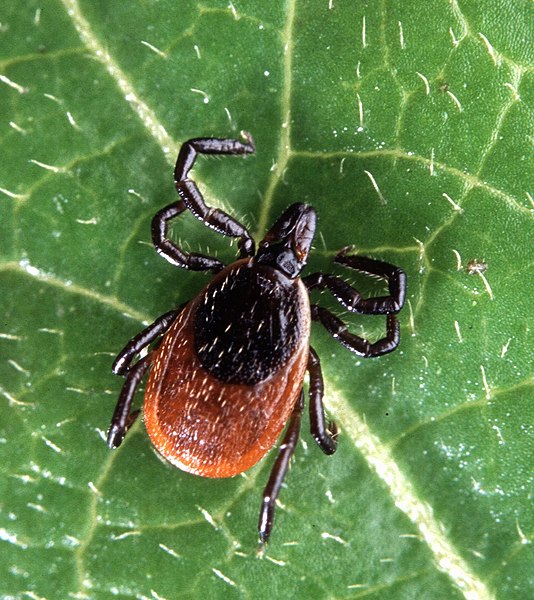- Stay on trails outdoors; avoid areas of overgrown brush and tall grasses. (The Live Animal Exhibit trail at the Science Center is wide, so it makes it easy to avoid brushy and grassy areas. You are not at increased risk for tick exposure walking on our trails compared to any other natural area.)
- Wear light-colored clothing so ticks can be easily seen.
- Wear long pants, a long-sleeved shirt, closed toe shoes with socks, and a hat. Tuck your pants into your socks and your shirt into your pants.
- Check yourself, your children, and your pets often for ticks, shower after returning indoors.
- Use insect repellent containing DEET or permethrin (always follow directions).
- After returning indoors, run clothes in the dryer on high heat to kill any ticks that may be on the clothing.
.jpg/729px-American_Dog_Tick_(Dermacentor_variabilis).jpg) |
| American dog tick (Dermacentor variabilis) Wikimedia/ Jerry Kirkhart |
 |
| Black-legged tick (deer tick) - Ixodes scapularis Wikimedia/USDA |
carry Rocky Mountain Spotted Fever and Tularemia. To transmit the disease to you, the tick has
to be biting you for over two hours. If you do a thorough body check when you get home there
is no need to worry.
How do I know if it is a wood tick or a deer tick? Not all ticks carry Lyme Disease. Deer ticks
are known to carry Lyme Disease but wood ticks are not. Wood ticks are quite a bit bigger than
deer ticks. Deer ticks are usually only the size of a head of a pin, while the wood tick can get to
the size of a small raisin when engorged with blood. If you are in doubt of what species of tick
you see, ask one of our naturalists!
Here are a few more helpful links:
Biology and Management of Ticks in New Hampshire - UNH Cooperative Extension
Tick Tips - UNH Cooperative Extension
Insect Repellents - UNH Cooperative Extension
https://www.cdc.gov/ticks/avoid/on_people.html https://www.dhhs.nh.gov/dphs/cdcs/lyme/documents/tickbites.pdf
We're looking forward to seeing you on the trail this season!

No comments:
Post a Comment